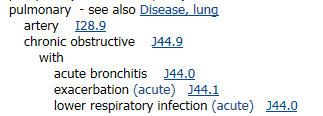Inside Angle
From 3M Health Information Systems
Just a little fender bender? How coding changes affect readmission scores
So, that minor fender bender? When you take your car into the shop, sometimes there is much more damage under the fender than previously thought. Sometimes changes to the official code set, the alphabetical and tabular list and Coding Clinic advice seem to have just a minor visible impact, but only looking under the fender tells the whole story.
Last year, in conjunction with the release of the ICD-10-CM code set, there were changes to the alphabetical and tabular indexes regarding sequencing of COPD and pneumonia. However, the alphabetical index and tabular list weren’t perfectly clear and many in the industry had questions. Others did not even notice the subtle (but not so subtle) change.
Under the alphabetical index is the following:
And under the tabular:
Hmm, so what is an LRTI (lower respiratory tract infection); pneumonia, bronchitis, influenza? And does the index and instructional note provide sequencing? Many clients have asked us questions on this topic. Some in the industry feel that this was not intentional, as there was no such note in ICD-9-CM and this “probably” meant just bronchitis. Well, many letters were sent to Coding Clinic and just recently (3rd Quarter 2016), Coding Clinic addressed this issue. They provided some overall guidance and then posted several question and answer examples.
To summarize, pneumonia and bronchitis are determined to be LRTIs and influenza is not. Additionally, the posted examples noted that COPD is to be sequenced over pneumonia even if the COPD is stable and not as “equally” treated as the pneumonia on this admission. Further confusing is the advice to code more than one code from the J44 range if the patient also has bronchitis or an exacerbation, etc.
Okay, so for those whose heads are now spinning: Based on the current alphabetical index, tabular list and official guidance, the chronic compensated condition (or decompensated in some cases) is sequenced over the acute condition (pneumonia).
In terms of reimbursement, if the pneumonia is classified to a “simple” pneumonia, this may result in a higher reimbursement. But what about the bacterial pneumonias included under MS-DRGs 177-179? Yup, those must also be sequenced as secondary, potentially resulting in lower reimbursement.
Whether or not aspiration pneumonia applies to this scenario is yet to be determined due to an excluded note for J60-J70 (in which aspiration pneumonia resides). I encourage facilities to submit this question to get clear guidance.
I digress a bit, as this conversation was meant to focus on quality, but I did need to explain the big issue in order to discuss the quality implications. Back to quality. When you look under the fender you may note the potential impact on the Hospital Readmissions Reduction Program (HRRP), aka PPR program scores. There will be fewer reported cases of pneumonia as principal diagnoses (and hence, fewer indexed visits from which the 30-day clock will start counting). This may lead an organization into a false sense of improvement. And how many reduced readmissions are due to quality of care/care transition as compared to shifts due to changes in coding guidance? Pretty impossible to tell.
Conversely, there will be an uptick in cases assigned with COPD as principal diagnosis and an increase in readmissions in this cohort. For those who might not fully understand the COPD cohort, when COPD is the principal diagnosis, it includes all types, not just those in exacerbation or with acute bronchitis or asthma. Only when COPD is sequenced as secondary, with respiratory failure as PDx, does the COPD have to be noted as an exacerbation to be included in the cohort.
So will CMS redefine the COPD cohort? Or will the CDC revise the coding and indexing of COPD and pneumonia? Time will tell.
But remember, always check completely under the fender to understand the full extent of the implication(s) of a simple code change, index change or official guidance. Drive safely!
Cheryl Manchenton is a senior inpatient consultant and project manager for 3M Health Information Systems.




